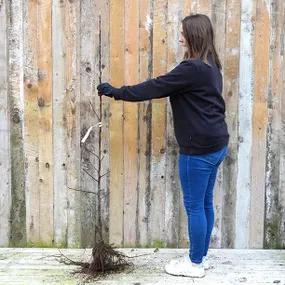Winter Gem Eating Apple Trees
Honest Delivery Prices- Use: Eating
- Pruning: Spur bearer
- Pollination: Self Sterile
- Picking: Oct
- Apple colour: Red/Green
- Pollination: Group D
- Storage: 2 months
- Resistant to bitter pit & cankers
Description
Winter Gem Apple Trees: Eating, Late Season
With its sensational, rich taste and keeping properties Winter Gem is really useful, maintaining that late apple season into the New Year. It's an exceptional eating apple, outstandingly aromatic, with just the right mix of acid, juiciness and sweetness, but only entrepreneurial farm shops stock it from small growers.
Ripening in late October, perfect for apple bobbing, it is one of the last eaters to crop, when the medium-sized green fruit are flushed with red.
The average crop size suits the home grower with limited storage space.
It flowers in the first half of May producing white and fragrant blossom.
Browse our range of apple trees, or all our fruit trees.
Read our guide to buying apples.
Delivery season: Bareroot plants are delivered in late Autumn to Spring, about November-March inclusive. Pot grown plants, year round.
Features:
- Use: Eating
- Not commercially grown
- Modest crop size
- Spur bearer (good for cordons & espaliers)
- Pollination: Self Sterile
- Pollination: Group D
- White blossom
- Picking: late October
- Apple colour: Red/Green
- Storage: Excellent
Growing Winter Gem Apples
Apples like rich, well drained soil, and will thrive on clay in locations that do not get waterlogged in winter.
A full day of sun and shelter from the wind is ideal.
Disease Notes:
Extremely resistant to bitter pit and cankers.
Rootstocks:
We use MM106 for Winter Gem, the UK standard for medium-sized trees, ideal for gardeners. It gives a half-standard about 4m tall, and a bush about 3m.
MM106 maidens are suitable for cordons and espaliers, but we use the less vigorous M9 for our ready-made cordons.
Pollination Partners
Your trees are self sterile and their flowers must be pollinated to make fruit.
Winter Gem is in Pollination Group D, which cross-pollinates with other apple trees in Groups C, D, and E.
Discovery, which crops in August, and Blenheim Orange in September would make a great set of partners.
Use our Fruit Pollination Checker to quickly find pollination partners, or Apple Tree Pollination Guide to learn more.
Planting Instructions
Notes on planting apple trees:
All fruit trees like a rich soil with decent drainage, protection from the wind and plenty of sun. Apple trees like clay soil, as long as it is not prone to bad waterlogging.
Prepare your site before planting:
Improving the soil helps trees establish quickly and be productive for years. Preparing weeks or months in advance gives best results: fill the planting hole back up, don't leave it open to either dry out or fill with water.
Do not plant less than 30cm from a wall.
- Destroy weeds and grass,
- Dig the soil over in a square of at least 1 metre, remove stones, then mix in well rotted compost or manure down to the depth of about 2 spades, unless you are on heavy clay:
- On thick clay soil, only dig over the soil to break it up. Apply organic matter as a mulch over the soil after planting.
Soak the tree roots in water for about an hour before planting.
Spacing apple trees:
- Freestanding bushes: 15-18 feet (5-6m) between trees and rows.
- Freestanding half-standards: 18-30 feet (6-10m) between trees and rows.
In general, allow 1 more metre between rows than between trees along the row.
- Wire-trained cordons: 60-100cm apart along a row.
- Espaliers: 10-18 feet (3.5-6m) apart.
- Watch how to plant a fruit tree for a bush or half-standard.
- To grow a cordon or espalier, you need to install sturdy training wires.
Water well after planting, mulch the dug over area, and water weekly through the first summer.
Pruning apple trees:
- Maidens can be pruned in any style, including into bushes or half-standards.
- Bushes - start here when you buy a bush.
- Half-standards - start here when you buy a half-standard.
Accessories:
For bush and half standard apple trees, a tree planting pack, which includes a wooden support stake & rubber tie (a bamboo cane is enough support for a maiden), and a biodegradable mulch mat, with pegs, to preserve soil moisture stops and prevent weeds.
We strongly recommend using mycorrhizal "friendly fungi" on the roots of all transplanted trees.
Winter wash and grease are effective, organic pest prevention.
Did You Know?
Raised by Hugh Ermen in Kent in 1975, this relatively modern apple's parents are Cox's Orange Pippin and the less known Grimes Golden, an American cider apple that looks like a Golden Delicious. Mr Ermen struck a rich seam when he chose to cross these two dissimilar apples.
It was introduced onto the market in 1993 by Frank P Matthews.
Apple Tree Delivery Shapes:
Most of our fruit trees are delivered in up to 3 shapes (maiden, bush, and half standard), scroll up to see what's in stock.
Maiden: Unbranched tree, the most basic starting size, which you can train into the other forms (apart from mini patio trees).
Bush: Freestanding tree with a short trunk about 60cm tall. It will grow to about 3m. Ideal for small gardens.
Half-Standard: A freestanding form with a trunk about 120cm tall. It will grow into a full sized, "normal" apple tree, about 4m. Ideal for orchards, easy to mow underneath.
Cordon: Winter Gem is a spur-bearer, suitable for cordons and espaliers.
Guide to Fruit Tree Sizing.

 1.webp)
 1.webp)
 2.webp)
 3.webp)
